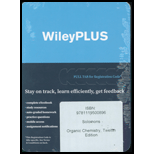
ORGANIC CHEMISTRY-WILEYPLUS ACCESS PKG.
12th Edition
ISBN: 9781119766919
Author: Solomons
Publisher: WILEY
expand_more
expand_more
format_list_bulleted
Textbook Question
Chapter 7, Problem 10PP
Practice Problem 7.10
When cis-1-bromo-4-tert-butylcyclohexane is treated with sodium ethoxide in ethanol, it reacts rapidly; the product is 4-tert-butylcyclohexene. Under the same conditions, trans-1-bromo-4-tert-butylcyclohexane reacts very slowly. Write conformational structures and explain the difference in reactivity of these cis-trans isomers.
Expert Solution & Answer
Want to see the full answer?
Check out a sample textbook solution
Students have asked these similar questions
Part II. Identify whether the two protons in blue are homotopic, enantiopic, diasteriotopic, or heterotopic.
a)
HO
b)
Bri
H
HH
c)
d)
H
H H Br
0
None
Choose the option that is decreasing from biggest to smallest.
Group of answer choices:
100 m, 10000 mm, 100 cm, 100000 um, 10000000 nm
10000000 nm, 100000 um, 100 cm, 10000 mm, 100 m
10000000 nm, 100000 um, 10000 mm, 100 cm, 100 m
100 m, 100 cm, 10000 mm, 100000 um, 10000000 nm
Chapter 7 Solutions
ORGANIC CHEMISTRY-WILEYPLUS ACCESS PKG.
Ch. 7 - Prob. 1PPCh. 7 - Prob. 2PPCh. 7 - Prob. 3PPCh. 7 - Prob. 4PPCh. 7 - Practice Problem 7.5
How many stereoisomers are...Ch. 7 - Prob. 6PPCh. 7 - Prob. 7PPCh. 7 - PRACTICE PROBLEM 7.8
Examine Solved Problem 7.3....Ch. 7 - Prob. 9PPCh. 7 - Practice Problem 7.10 When...
Ch. 7 - Practice Problem 7.11
(a) When...Ch. 7 - Prob. 12PPCh. 7 - Prob. 13PPCh. 7 - Practice Problem 7.14
Dehydration of 2-propanol...Ch. 7 - Practice Problem 7.15
Rank the following alcohols...Ch. 7 - Practice Problem 7.16
Acid-catalyzed dehydration...Ch. 7 - Practice Problem 7.17 Acid-catalyzed dehydration...Ch. 7 - Prob. 18PPCh. 7 - Prob. 19PPCh. 7 - Practice Problem 7.20
Show how you might...Ch. 7 - Prob. 21PPCh. 7 - Prob. 22PPCh. 7 - Practice Problem 7.23
Write the structure of...Ch. 7 - Prob. 24PPCh. 7 - Prob. 25PPCh. 7 - Practice Problem 7.26 (a) Devise retrosynthetic...Ch. 7 - Each of the following names is incorrect, Give the...Ch. 7 - Prob. 28PCh. 7 - Prob. 29PCh. 7 - Give the IUPAC names for each of the following:...Ch. 7 - Prob. 31PCh. 7 - Prob. 32PCh. 7 - Prob. 33PCh. 7 - Prob. 34PCh. 7 - 7.35. Write structural formulas for all the...Ch. 7 - 7.36. Explain the following observations: When...Ch. 7 - Prob. 37PCh. 7 - Arrange the following alcohols in order of their...Ch. 7 - Prob. 39PPCh. 7 - Prob. 40PPCh. 7 - Prob. 41PPCh. 7 - Prob. 42PPCh. 7 - Your task is to prepare isopropyl methyl ether by...Ch. 7 - Prob. 44PCh. 7 - Prob. 45PCh. 7 - Prob. 46PCh. 7 - 7.47. Starting with an appropriate alkyl halide...Ch. 7 - Prob. 48PCh. 7 - 7.49. What is the index of hydrogen deficiency...Ch. 7 - Prob. 50PCh. 7 - Prob. 51PCh. 7 - Compounds I and J both have the molecular formula...Ch. 7 - Prob. 53PCh. 7 - 7.54. Outline a synthesis of phenylethyne from...Ch. 7 - Prob. 55PPCh. 7 - Prob. 56PPCh. 7 - Prob. 57PPCh. 7 - cis-4-Bromocyclohexanol tBuOHtBuO racemic C6H10O...Ch. 7 - Prob. 59PPCh. 7 - Consider the interconversion of cis-2-butene and...Ch. 7 - Prob. 61PCh. 7 - (a) Using reactions studied in this chapter, show...Ch. 7 - Prob. 63PCh. 7 - Prob. 64PCh. 7 - 1. Write the structure(s) of the major product(s)...Ch. 7 - Prob. 2LGPCh. 7 - (a) Write the structure of the product(s) formed...Ch. 7 - Prob. 4LGP
Additional Science Textbook Solutions
Find more solutions based on key concepts
PRACTICE 1.3 The melting point of table salt is 1474oF. What temperature is this on the Celsius and Kelvin scal...
Chemistry (7th Edition)
Contrast the fertility of an allotetraploid with an autotriploid and an autotetraploid.
Concepts of Genetics (12th Edition)
A source of electromagnetic radiation produces infrared light. Which of the following could be the wavelength ...
Chemistry: The Central Science (14th Edition)
Explain how the use of an oxygen isotope helped elucidate the chemistry of photosynthesis.
Campbell Biology (11th Edition)
Why are BSL-4 suits pressurized? Why not just wear tough regular suits?
Microbiology with Diseases by Body System (5th Edition)
Periodic table must be used to find the atomic symbol, atomic number, group number, number of protons and numbe...
Living By Chemistry: First Edition Textbook
Knowledge Booster
Learn more about
Need a deep-dive on the concept behind this application? Look no further. Learn more about this topic, chemistry and related others by exploring similar questions and additional content below.Similar questions
- Q1. (a) Draw equations for homolytic and heterolytic cleavages of the N-H bond in NH3. Use curved arrows to show the electron movement. (b) Draw equations for homolytic and heterolytic cleavages of the N-H bond in NH4*. Use curved arrows to show the electron movement.arrow_forwardWhich is NOT the typical size of a bacteria? 1000 nm 0.001 mm 0.01 mm 1 umarrow_forwardNonearrow_forward
- Show work. don't give Ai generated solutionarrow_forwardPart II. count the expected number of signals in the 1H-NMR spectrum of these compounds HO 0 одев * Cl -cl "D"arrow_forwardPart I. Create a splitting tree diagram to predict the multiplet pattern of proton Hb in the compound below: 3 (Assume that "Jab >>> ³JbC) Ha Hb He он Ha NH2 Ha HCarrow_forward
- SH 0 iq noitzouDarrow_forwardNonearrow_forward+ HCl →? Draw the molecule on the canvas by choosing buttons from the Tools (for bonas), Atoms and Advanced Template toolbars. The single bond is active by default. + M C + H± 2D EXP. CONT. K ? L 1 H₁₂C [1] A HCN O S CH3 CH 3 CI Br HC H₂ CH CH CH3 - P Farrow_forward
arrow_back_ios
SEE MORE QUESTIONS
arrow_forward_ios
Recommended textbooks for you

07 Physical Properties of Organic Compounds; Author: Mindset;https://www.youtube.com/watch?v=UjlSgwq4w6U;License: Standard YouTube License, CC-BY